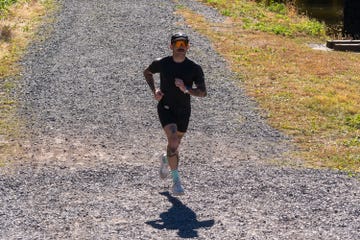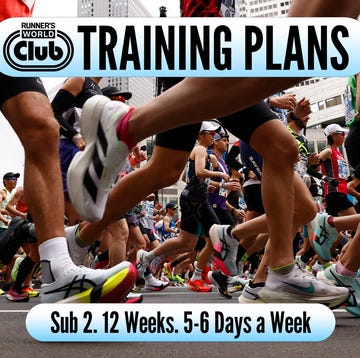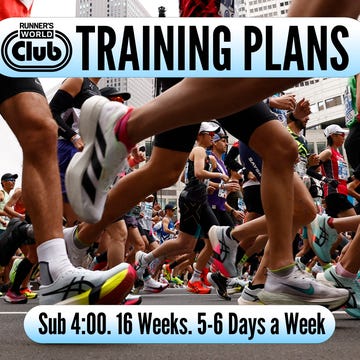Like stalactites and stalagmites, most of us have heard of ‘aerobic’ and ‘anaerobic’, although we might struggle to remember which is which. Here, we’ll help you to clarify the terms and understand how both aerobic exercise and anaerobic exercise can benefit your running. We’ll also clear up some common misconceptions and teach you how to mix different intensities into your training, which all adds up to increased running ‘might’ – or is it ‘tight’?
Defining running intensity
Put simply, aerobic and anaerobic refer to the different ways in which your body produces energy while you’re running. We use the words to distinguish between different running intensities and to define the different training zones and thresholds.
Adenosine triphosphate (ATP) is the ‘currency’ that your body uses to produce the energy required to run. To sustain longer periods of running, or multiple bouts of running (for example, during an interval session), your body needs to replenish this ATP and it will do this via both aerobic and anaerobic means.
What everyone's reading
What is aerobic exercise?
The term aerobic exercise is commonly used to refer to activities that primarily use oxygen to generate energy. During aerobic exercise, your body relies on a continuous supply of oxygen to break down carbohydrates, proteins and fats, providing the fuel that it needs for sustained running. Everything from a leisurely stroll and conversational jog with friends up to the kind of run where pick up the pace but still have something in the tank – say, an effort of six or seven out of 10 – counts as an aerobic session. The key to understanding training at an aerobic intensity is that it involves the ability to sustain effort for extended periods without feeling excessively fatigued.
What is anaerobic exercise?
When your oxygen supply is unable to provide enough energy, your body relies on anaerobic energy production, which means looking for extra energy stored in the muscles. You need anaerobic energy when you’re doing shorter, more intense blasts of running or sprinting, where your effort levels get higher quickly, your heart beats a lot faster and your breathing becomes more rapid. We’re talking an effort of at least eight or nine out of 10, or a pace that you can only maintain for a short period before everything screams at you to slow down. To complicate things a little further, anaerobic energy production is typically split into two systems, which are explained here...
The glycolytic system
This will provide a significant amount of the energy in hard efforts lasting from about 10 seconds through to about two to three minutes. Your body uses its stored glycogen to create energy rapidly, but it doesn’t last long and is associated with a rapid increase in fatigue and markers of fatigue, such as blood lactate.
The Creatine Phosphate (CP) system
This provides energy using creatine phosphate stored in the muscles. While this energy is provided very quickly, it also depletes very quickly and typically only lasts for around eight to 10 seconds – then, a significant period of time is needed to replenish these energy stores. This system is relied upon when sprinting and when ‘getting going’ at the start of races.
How to apply aerobic and anaerobic systems to your training
Training that relies on aerobic energy production can involve everything from easy runs, either short or long, to tempo or threshold runs. If you want to increase the contribution of anaerobic energy production in any run, you will likely need to do this with some form of interval-based training, where you work hard in short bursts, then recover before repeating the hard effort. The key to getting your sessions right is knowing that the harder you work, the greater the percentage of anaerobic energy you will require. As a result, you’ll both reduce the amount of time that you can run at that effort and increase the recovery time that you’ll need between efforts.
How to make smart training decisions
You need to consider a range of things when structuring your training, each of which will influence your optimum balance of aerobic and anaerobic energy production.
Race demands
The majority of races that you’re likely to run will rely on a very high percentage of aerobic energy. Even 1500m races will typically see around 85% of energy contribution coming from aerobic sources – and as you go longer, the aerobic contribution increases.
Top tip
If you’re racing on hilly or uneven terrain, be aware that your body may have short periods of increased anaerobic energy production, even in longer races. The same is also true in races where you might have short surges of pace. To prepare for this, do interval sessions or fartlek runs which mix short, fast efforts with longer periods of running at a steadier intensity.
Intensity
At lower intensities, your body can use a greater percentage of aerobic energy production. At higher intensities, particularly beyond what is commonly called your lactate turnpoint, your body will rely on an increasing the amount of anaerobic energy product to sustain your pace.
Top tip
There are a range of ways that you can monitor your running intensity. Some, such as heart rate, can be more useful for putting a cap on your aerobic-focused sessions, while others, such as perceived effort, timed splits or power, might be more useful for your anaerobic-focused work.
Duration and volume
After a short period of high-intensity running, your body will have rapidly depleted its creatine phosphate and glycogen stores – so the longer you try to run, or the more repetitions you aim for at a high intensity, the more that depletion of fuel stores will mean that your body is forced to rely on aerobic energy production.
Top tip
If you want a greater percentage of anaerobic contribution in a session, you need to use interval-based training. Here, you should do efforts of typically two minutes or less for the glycolytic system and eight seconds or less for the creatine phosphate system.
Recovery
During an interval session, the greater the percentage of anaerobic energy that you use, the longer the recover that you’ll need between efforts to hold the session together.
Top tip
A simple way to ensure that an interval or fartlek session has more of an aerobic focus is to stick with very short recoveries, or to keep jogging or running at an easy pace on your recoveries. Conversely, if you want to run at intensities which rely on anaerobic energy production, give yourself long recoveries. I will often set hill sprints of eight seconds, followed by two or three minutes of rest.
Fitness level
Runners who are new to the sport may have much less of an aerobic buffer before they start to rely on anaerobic energy production.
Top tip
Newer runners targeting longer distances will generally benefit from spending a good period of time focused on easy running and more aerobic-focused sessions. Then, they can add more anaerobic-focused sessions later in their training.
It’s not quite either/or
Got all that? Great – let’s now make things a little more complicated. It’s important to understand that your body does not neatly separate aerobic and anaerobic energy systems. Instead, they exist on a continuum and work in tandem to meet the demands of running. Both aerobic and anaerobic processes are simultaneously active, albeit to varying degrees. Even during low-intensity running, anaerobic energy pathways contribute to overall energy production. Similarly, during high-intensity anaerobic activities, the aerobic system continues to play a role in supporting energy production.
This means that we shouldn’t neglect one type of exercise in favour of the other. It’s much more beneficial to create an integrated training regimen that incorporates both elements. A study published in 2023, for instance, found that mixing the order of aerobic and anaerobic training in male 3000m hurdlers led to a significant improvement in performance.
Aerobic and anaerobic training should be seen as complementary rather than mutually exclusive because of their mutual influence on physiological adaptations. Aerobic exercise, with its emphasis on sustained effort, enhances cardiovascular fitness, improves endurance and increases the efficiency of oxygen utilisation. These adaptations, in turn, benefit anaerobic performance by facilitating faster recovery between bouts of intense exercise. Conversely, anaerobic training, which focuses on power and strength, can enhance the body’s ability to generate force, leading to improved performance in both aerobic and anaerobic activities.
Embracing a more holistic approach to your running allows for greater versatility and flexibility in training. By incorporating a mix of aerobic and anaerobic dominant intensities, you can enjoy a more diverse and engaging plan. This variety not only prevents boredom, but also helps to prevent overuse injuries that can occur from repetitive movements associated with exclusively focusing on one type of training. It will also give you more physical tools in your armoury.
The bigger picture with aerobic and anaerobic exercise
My mentor at Stirling University, Dr Andrew Kirkland, was a big influence in my thinking about training and coaching. Building on an article written by Mark Hargreaves and published in the Journal of Applied Physiology, Kirkland argues that there is a false dichotomy – and that thinking about your running in simple aerobic/anaerobic or ‘metabolic’ terms is oversimplifying things.
He argues that a wide range of factors, such as muscle activation, psychology, fuelling and even the social environment in which you run and race, will have as much – if not more – of an impact than the training zone that you use and the split of aerobic and anaerobic energy linked to it.
So now that you understand the different definitions, you can focus on what’s really important: keeping consistency in your training, working at a mix of intensities, keeping injuries at bay and having fun.













